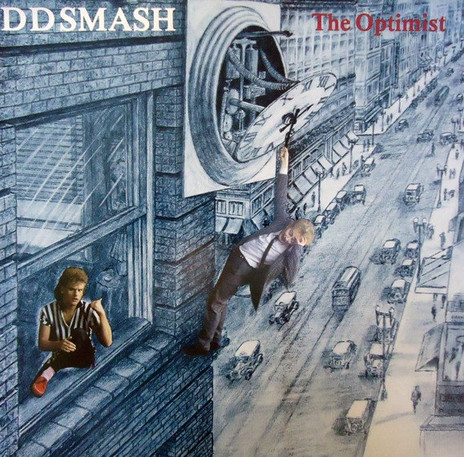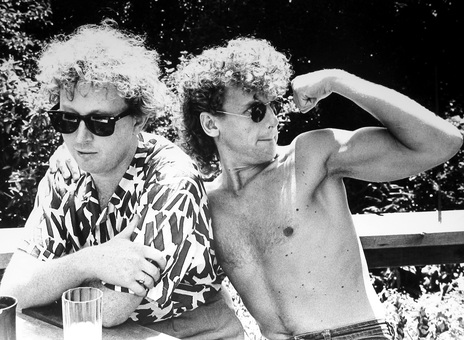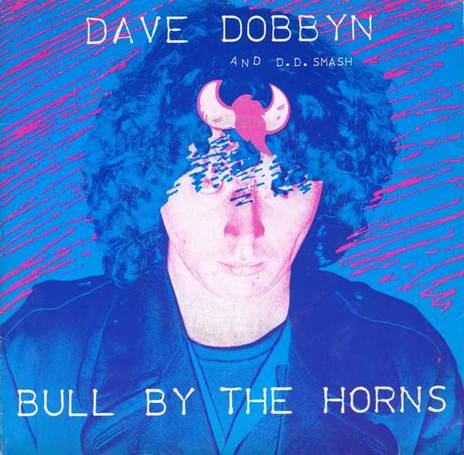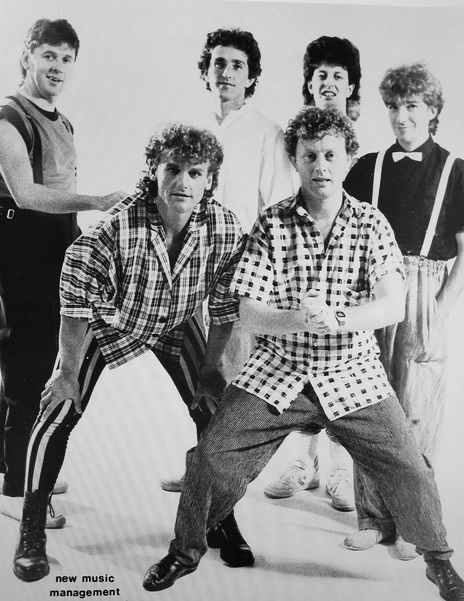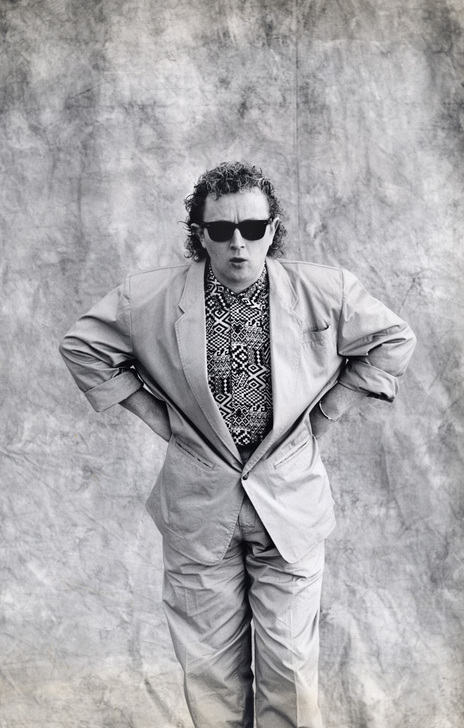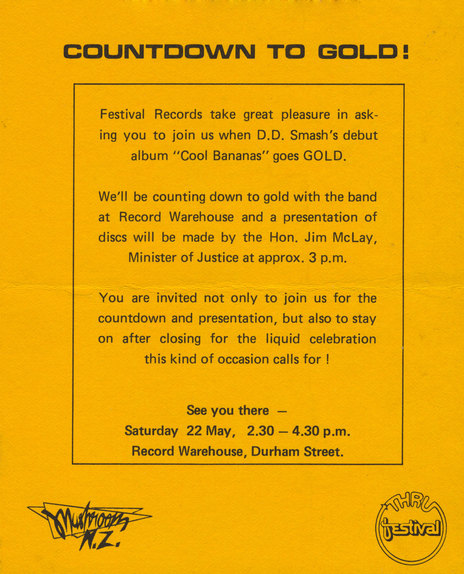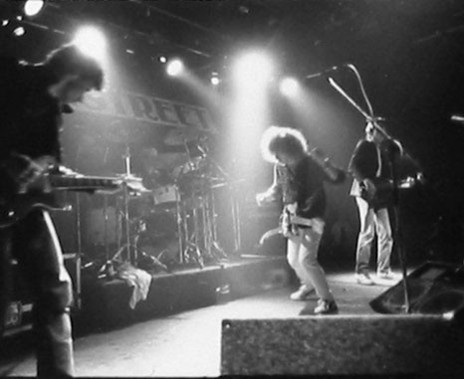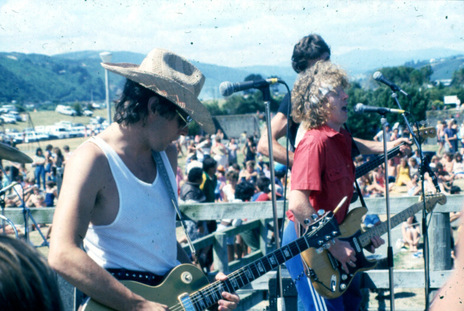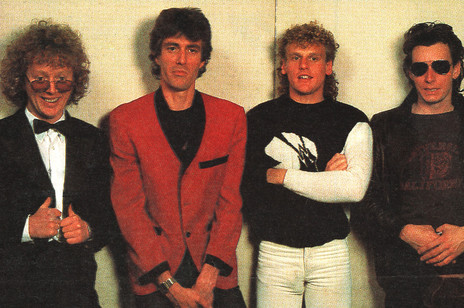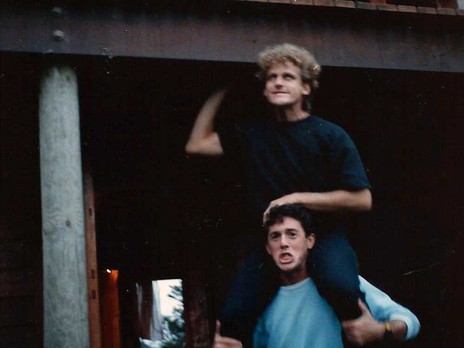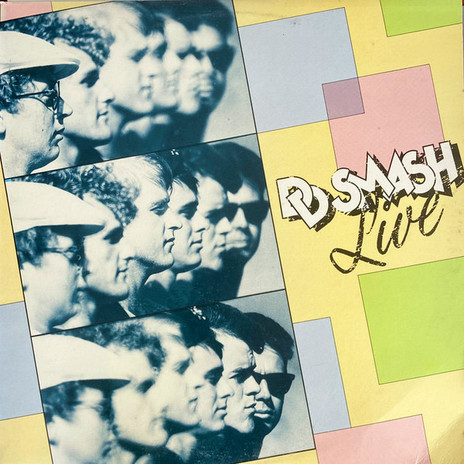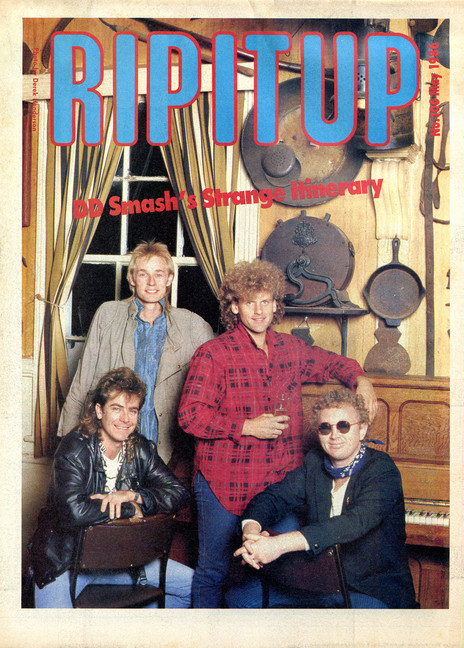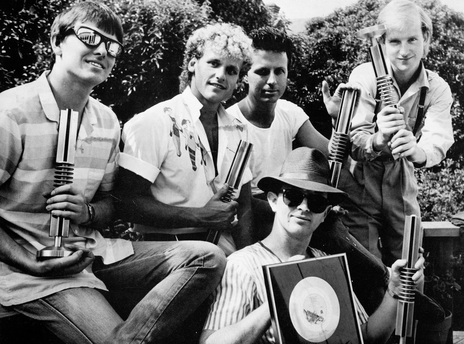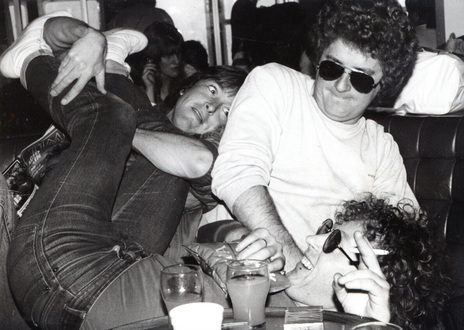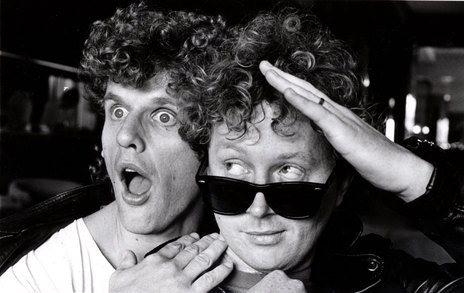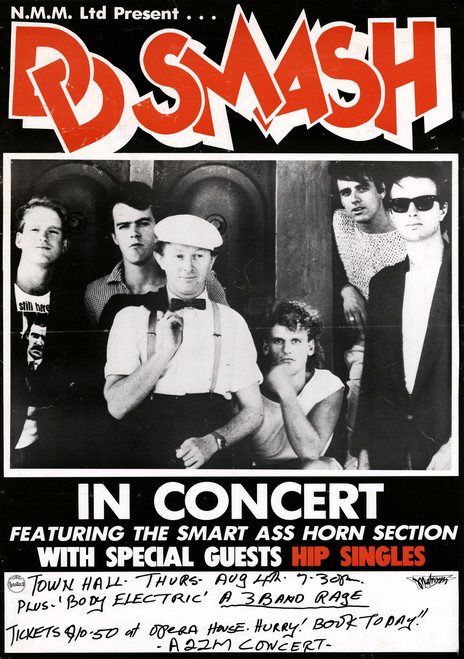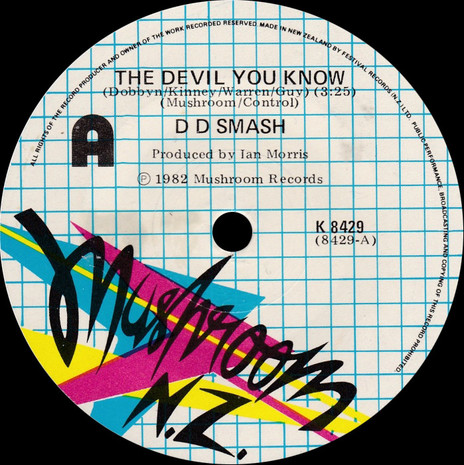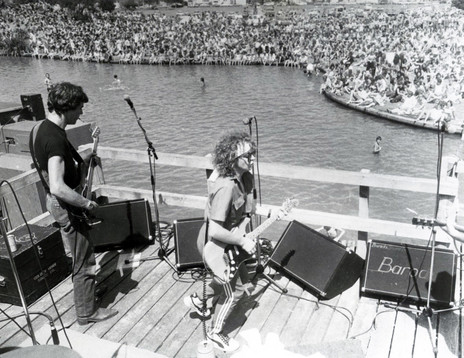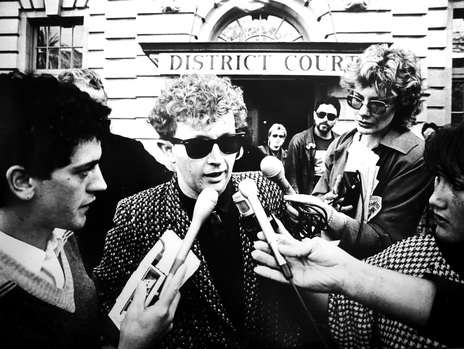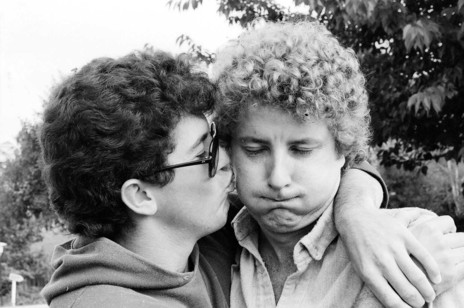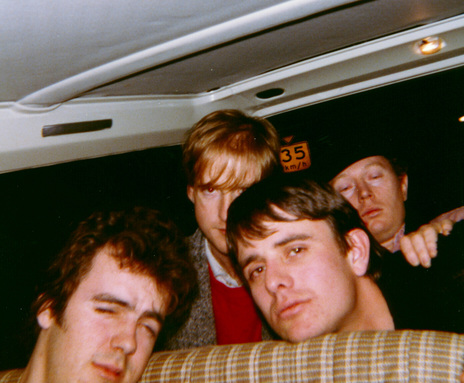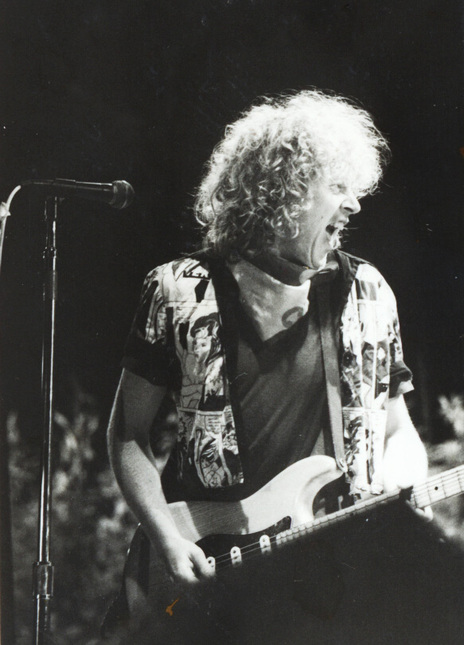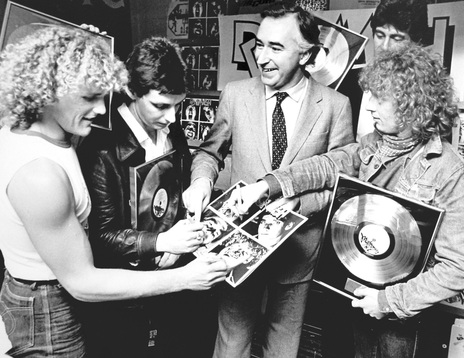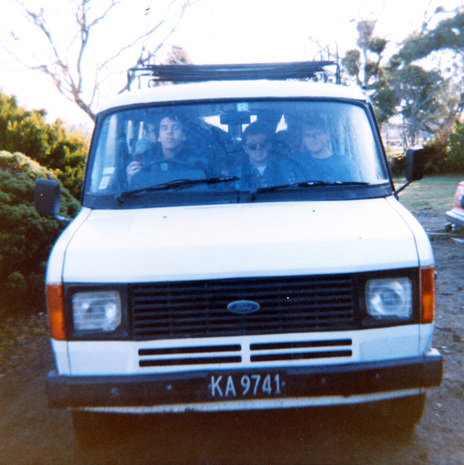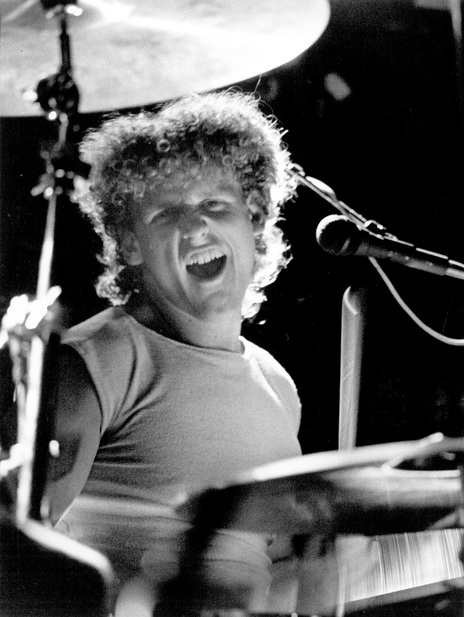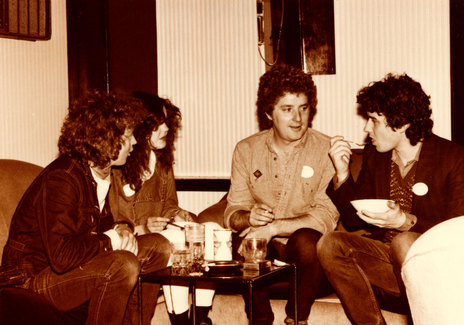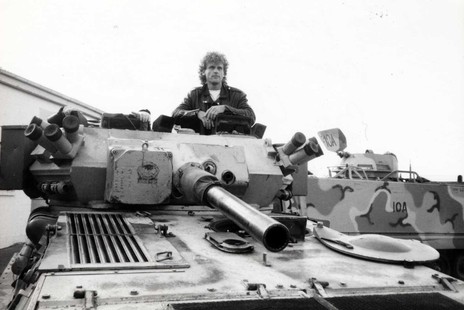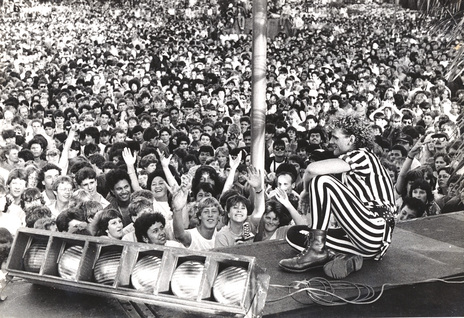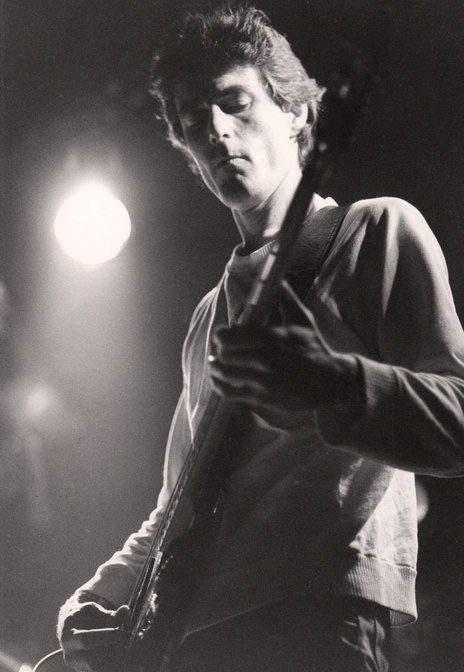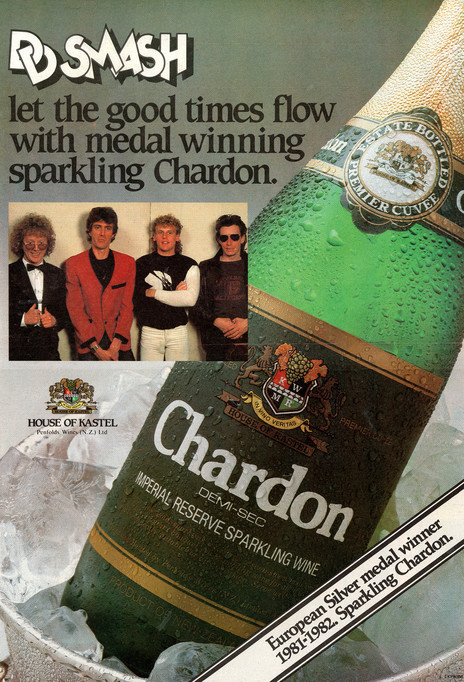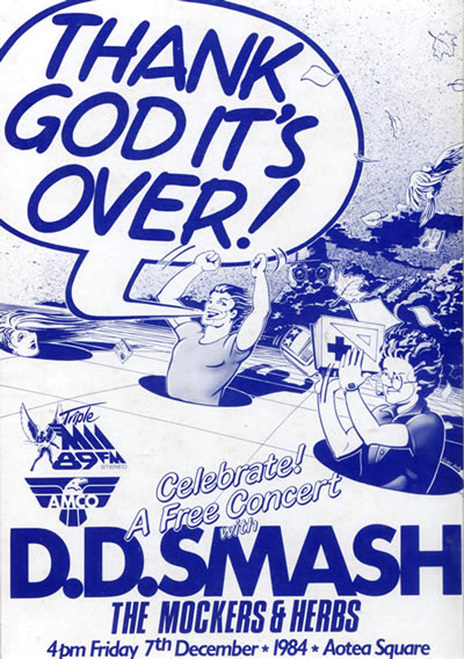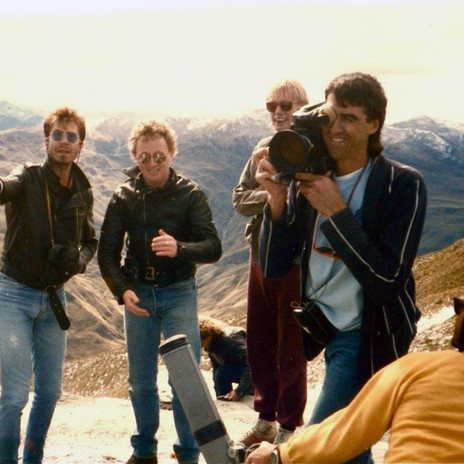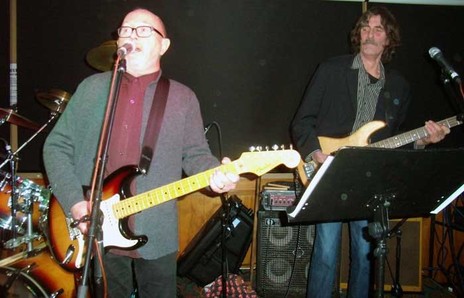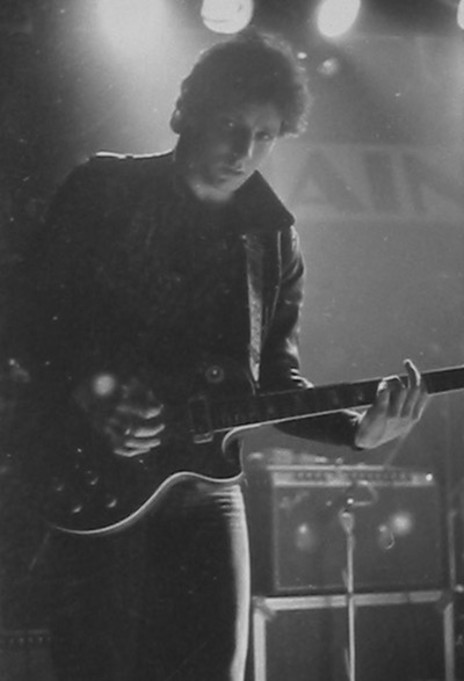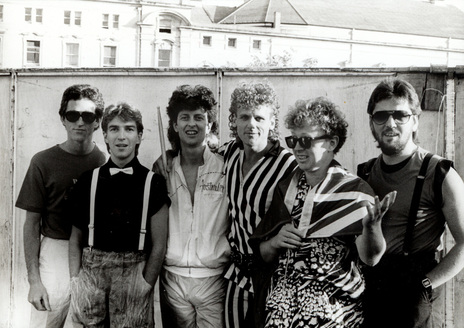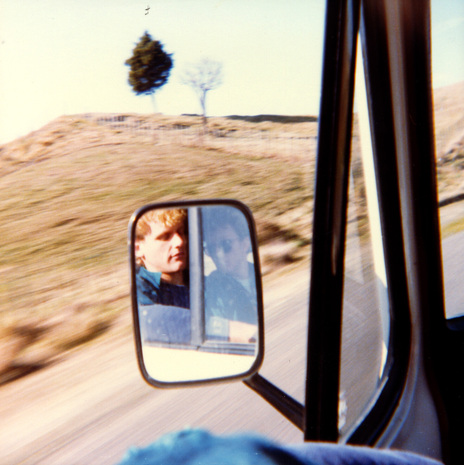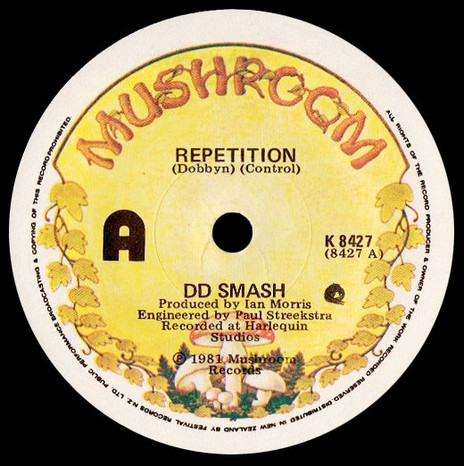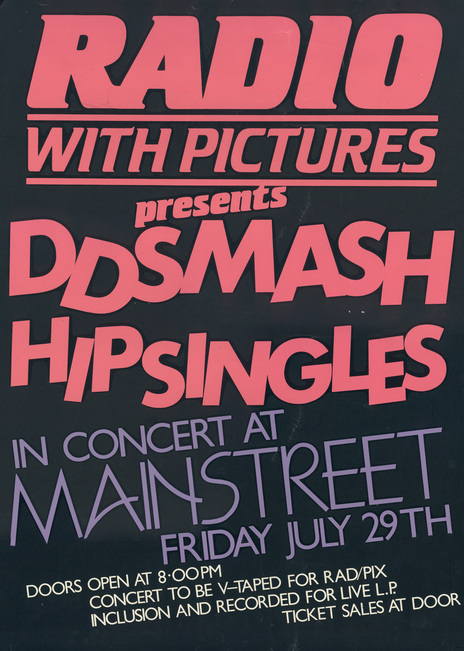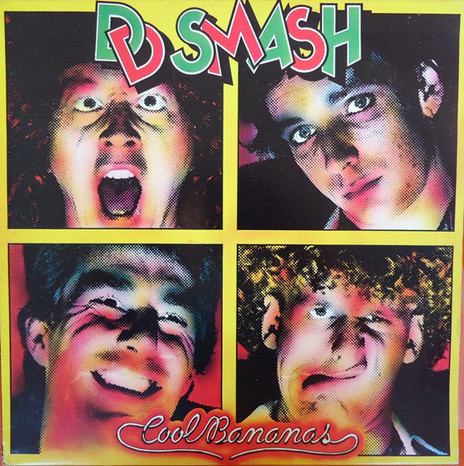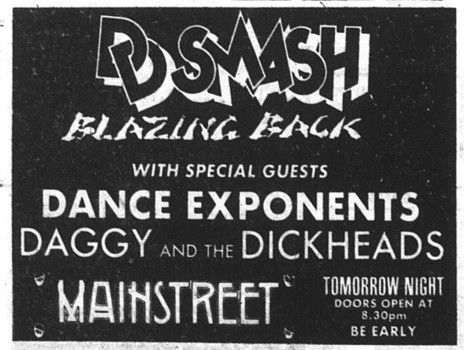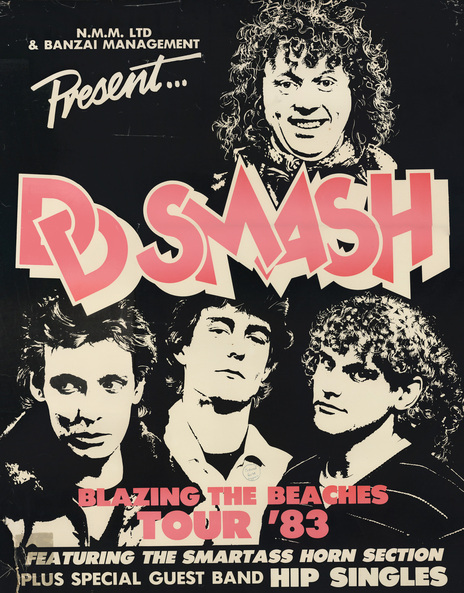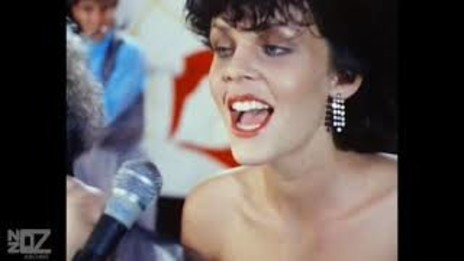It’s also fair to say DD Smash were the New Zealand band whose sound evolved farthest from its booze-barn origins as Dobbyn’s songwriting matured from the anthems of Th’ Dudes and Cool Bananas to the ginger-haired, blue-eyed soul man of The Optimist.
After several trips back and forth across the Tasman, in 1983 DD Smash settled in Sydney where they were mostly lost amongst the Australian guitar rock of the era and often accused in the street press of lacking an image.
Never mind, they could always count on a quick trip home to fill the coffers. Until the Queen Street Riot on 7 December 1984, that is. DD Smash were early in their set at the Thank God It’s Over concert at Auckland’s Aotea Square when mayhem broke out around them. Police tried to blame the resulting carnage on Dave Dobbyn.
The original lineup formed around Auckland’s inner city with the bringing together of members of Th’ Dudes, Lip Service and Hello Sailor, then chopped and changed until all that remained from DD Smash’s Cool Bananas heyday when Dobbyn called time in 1987 were he and drummer Peter Warren. It had more or less been about them from the beginning: DD and Smash.
After Th’ Dudes ran out of steam in May 1980, their guitarist and songwriter Dave Dobbyn spent about three months writing songs and watching television. His writing partner, Ian Morris, returned to his role as engineer at Stebbing Recording Studio where he would record Dobbyn’s new songs during the graveyard shift.
The fruits of their labour were released on Epic as singles ‘Lipstick Power’, in December 1980, and ‘Bull By The Horns’, in July 1981. Although only Dobbyn, Morris and Stebbing house producer Rob Aickin were present, the latter single was credited to Dave Dobbyn and DD Smash. See, by then the singer had found himself a new band.
At the Reverb Room in Auckland, Dobbyn caught up with drummer Peter “Rooda” Warren
At the Reverb Room in Auckland’s Symonds Street around April 1981, Dobbyn caught up with drummer Peter “Rooda” Warren and guitarist Rob “Revox” Guy, both from the floundering Lip Service, and they decided to band together. Soon after at the Rumba Bar, Dobbyn recruited former Hello Sailor bassist Lisle “The Duke” Kinney.
Hello Sailor’s Dave McArtney recalled in his memoir Gutter Black that at the time, “Every Tom, Dick and Harry in the Auckland music scene in 1981 was wondering what the ginger-headed bare-skinned baby would do next.
“Dave was lurking tentatively in the wings of the industry, coiled (not only the hair) and ready to spring into action, and unleash his prodigious talents onto the world ... ‘tentatively’, though, because the old Dobbyn was painfully shy. He almost thought he needed to ask my permission to hire the Duke as his bass player. I remember one drunken evening at the Rumba Bar when I begged him to give the Duke a job, which he did that same night.”
Their first gigs were as Dave Dobbyn’s Divers at the Rumba Bar on June 15 and 17. Record Warehouse co-owner Roger King checked out the Divers’ show at Milford Marina after Dobbyn put up a poster at his shop. Later, most of the band ended up at King’s Devonport flat where loose discussions about management ensued.
Before their appearances at the Station Hotel the following month, the band was renamed when Warren came up with DD Smash – the DD for Dave Dobbyn and Smash for a nickname Dobbyn had bestowed on Warren. Soon after, the solo ‘Bull By The Horns’ came out under the Dave Dobbyn and DD Smash moniker.
In August, Dobbyn was finding his feet as a frontman when DD Smash supported Dave McArtney & The Pink Flamingos’ farewell tour of the nation. “It took me a while to come to terms with standing in the middle of the stage, singing and playing guitar, with people looking my way,” he told Duncan Campbell in the following March’s Rip It Up. “I wasn’t confident of the songs or the performance.”
But audiences and the music industry were seduced by Dobbyn’s exuberance and quirky vocals and were shivering with anticipation of his next move. Roger King had manoeuvred his way onto the Flamingos tour and by the time they returned to Auckland he was officially DD Smash’s manager. In December, they became the first artist signed by Mike Chunn to the new Mushroom NZ label.
“I rang Michael [Gudinski] in 1981 and I said, ‘You should have a Mushroom Records NZ label,’” Chunn told AudioCulture in 2021. “Two days later he turned up with the artwork for that label and said, ‘Who are you gonna sign?’ I said, ‘DD Smash.’”
Produced by Ian Morris at Harlequin Studios, ‘Repetition’ was released in December on the eve of a national beaches tour. It spent several weeks going in and out of the chart before peaking at No.25 in February. While completing an LP with Morris at Harlequin, the band played Sweetwaters and opened for Elton John on March 13.
Dobbyn was excited about the impending album but hinted at an eclectic future in the Rip It Up of March 1982. “There are other possibilities, too. I’d like to do an album of other types of tunes. I really like romantic, melodic music, piano-oriented ballads, very small production and very big production all on the one album. These would be songs that I couldn’t use with DD Smash but could use on vinyl.”
In April, they set off on a national album tour with Christchurch trio The Narcs and raconteur Gary McCormick. When the album chart for the week ending April 21, 1982, was published, Cool Bananas had entered at No.1 – the first New Zealand album to ever achieve the feat. The following week, Split Enz’s Time and Tide duplicated the accomplishment when it knocked Cool Bananas from the top spot.
The tour was heading to Kaikoura when DD Smash received the news. “Roger King gets out, runs up to the phone box. We know he’s gonna phone up and find out what the charts are doing,” Dobbyn recalled on the C4 TV show Homegrown Profiles in 2005. “And then he puts his hand up in the window and goes, ‘No.1’. First week in, no radio airplay, purely because we’d been touring, slogging it right from the start. We’d spent a few weeks on the road, suddenly everyone knew who DD Smash were, and suddenly that record came in at No.1.”
They headlined a Radio With Pictures concert at the Christchurch Town Hall before testing the waters in Australia in June. There they appeared on pop show Countdown and undertook a month’s work in Melbourne, including a Split Enz support, before heading to Sydney and opening for a re-formed Dragon.
Initially, the Australian push had Dobbyn feeling … optimistic
“We turned up there and we’re on Mushroom Records, who had agreements with Premier Artists in Melbourne and the Harbour Agency in Sydney,” Roger King told AudioCulture. “So, you just go on their books, and they just start working you. And they’d put you with acts that they thought you would gel with, so for us that was The Divinyls, The Radiators; just being thrown to the wolves. I mean, they never got Dave.”
Initially, the Australian push had Dobbyn feeling … optimistic. “Because we’re signed to Mushroom we have to go there,” he told Gary Steel in In Touch magazine in May 1982. “Australia’s so goddamn exciting! There’s so much going on. Just take rock’n’roll. There’s more rock’n’roll happening in Sydney on a Friday night than there is happening in LA. There’s a lot of action – people demand a good time, which doesn’t happen here.”
Back in New Zealand in October, Dobbyn beefed up the DD Smash line-up with the addition of former Big Sideways keyboardist and trumpeter Scott Colhoun as well as saxophonist Andrew Clouston. Clouston had started in Wellington’s The Rodents and The Hulamen and had recorded in Auckland with The Neighbours, whose Rick Bryant had inspired Clouston to take up the sax when Clouston was just 13.
DD Smash and Cool Bananas cleaned up at the 1982 New Zealand Music Awards, taking album of the year and group of the year, male vocalist of the year and most promising male for Dobbyn, producer of the year for Ian Morris, engineer of the year for Paul Streekstra and Doug Rogers, and album cover of the year for artist Wayne Robinson.
On the eve of the Blazing the Beaches Tour, ex-Top Scientists guitarist Gary Langsford replaced Rob Guy. After just two gigs another change was forced when the vehicle Andrew Clouston and Lisle Kinney were travelling in was involved in an accident in the early hours of December 29.
Clouston spoke about the crash in 2003 on Radio New Zealand’s Musical Chairs. “Three o’clock in the morning, driving about 50 miles an hour on a country dirt road and just drove into a bank, basically. It was pretty bad. Like, I came to, you know, tangled up in the steering wheel of this old EH Holden. And I sort of woke up and climbed out and there was Lisle lying in a pool of blood in the middle of the road. I was sitting there, guarding him, just in case a car came round the corner and ran him over.”
Clouston required five stitches and missed the next two gigs, but Kinney suffered a fractured skull and memory loss and remained at Thames Hospital for weeks. Dobbyn’s Dudes bandmate Ian Morris and his girlfriend Kim Willoughby had been among the first on the scene, having taken in the gig at Whitianga. The following morning, Roger King enlisted Morris to fill in for Kinney for the remaining run.
‘Outlook For Thursday’ peaked at No.3, behind Michael Jackson’s ‘Beat It’
He was still considered a temporary member when DD Smash headed again for two months’ work in Australia in March 1983. The hook-and-horn-laden ‘Outlook For Thursday’ was released around the same time. Produced by Dobbyn, ‘Outlook For Thursday’ peaked at No.3 on the New Zealand singles chart behind Michael Jackson’s ‘Beat It’ and New Order’s ‘Blue Monday’.
Before returning briefly to New Zealand in June, it was announced that DD Smash – with Morris now an official member – would relocate permanently to Australia in July for a string of dates with Australian Crawl and to record their second album. The producer would be Charles Fisher, whose credits included Ol’ 55, Radio Birdman, Air Supply and Moving Pictures’ Australian and US hit ‘What About Me?’
Fisher flew back to New Zealand with DD Smash for a Radio With Pictures concert at Mainstreet on July 29 with the intention of a corresponding live EP before Christmas. When the somewhat ropey performance emerged two months later as seven-track LP Live: Deep In The Heart Of Taxes it carried the disclaimer “A one-night, one-shot recording, rescued by Charles Fisher.”
In the meantime, the hard slog across the Tasman was just starting. “We went to Sydney and did the Australian circuit, you know, up and down the east coast,” Andrew Clouston recalled on Musical Chairs. “And you’d play some huge room three hours’ drive out of Sydney and you’d be playing to three people who didn’t have a clue who you were. A lot of driving, a lot of playing to real small crowds.”
On Homegrown Profiles in 2005, Dobbyn recalled: “We toured in Australia and we played everywhere in Australia; every room you could think of. Then we’d come back to New Zealand and we’d earn New Zealand money and take it across the Tassie, it would be worth nothing! You’d get a third of your money back because the dollar was worth 43 cents Australian back then. We’d earn it here and then go over there and keep pouring it into touring. And, man, it was hard work.”
Drummer Peter Warren concurred: “We were playing as many as nine shows a week and mostly losing money,” he told AudioCulture in 2015. “To compete properly on the scene, we needed trucks with sound and lighting gear and a two- to three-man road crew, and it all costs. Basically, the support slots on the big tours subsidised our solo shows.”
Peter Warren: “We were playing as many as nine shows a week and mostly losing money”
The band’s popularity at home showed no abating with more success at the 1983 New Zealand Music Awards. DD Smash picked up best single for ‘Outlook For Thursday’, group of the year, best male vocalist, video of the year for the Andrew Shaw-directed ‘Outlook For Thursday’, most popular artist of the year and album of the year for Deep In The Heart Of Taxes.
The latter award raised some eyebrows, not least of all within the band. “That album is a complete anomaly,” Roger King recalled. “It won album of the year! Come on. It just seemed absurd. I mean, Jesus, was nothing else on offer that year?”
Coconut Rough, The Neighbours, Patsy Riggir, Brendan Dugan and even Monte Video could all justifiably feel a little cheated when, despite issuing LPs in 1983, the finalists for album of the year were live records from DD Smash and the combined Dance Exponents/Legionnaires, and a mini-album from Herbs.
It was announced before the Christmas-New Year North Island beaches tour that the jaunt would be the last for the current DD Smash incarnation. “The new songs require a change in arrangements,” Dobbyn explained in a December 1983 Rip It Up article. “The new material is a helluva long way from Cool Bananas. It’s more, dare I say it, mature in a lot of ways, especially rhythm and melody. It makes more interesting listening, and it sure as hell makes more interesting playing.”
Released in time for the tour, the single ‘Actor’, produced by Fisher, failed to make the New Zealand chart. Only Dobbyn, Warren, Ian Morris and Gary Langsford featured, with horns taken care of by Sydney session players. When DD Smash returned to Australia it was as a duo: Dobbyn and Warren.
Work began in earnest with Fisher at Trafalgar Studios, the facility he part-owned in Sydney’s Inner West, and Paradise Studios in Woolloomooloo. Dobbyn flew New Zealand bass guitarist/producer Bruce Lynch in for 10 days. Lynch had returned to Auckland to build Mandrill Studios in 1979, after six years and numerous sessions in Great Britain and two world tours with Cat Stevens.
After hold-ups due to complications from Dobbyn’s appendicitis, a taster was released in September 1984 in the shape of ‘Whaling’. Going on to become one of Dobbyn’s best-loved songs, ‘Whaling’ peaked at No.8 at the end of November. It would later be released in Australia as ‘Bravo Bravo (Whaling)’ after it became apparent radio programmers there weren’t much for subtlety.
‘The Optimist’ LP – a funky, soulful affair – featured the cream of Sydney session players
The Optimist followed in November and peaked at No.6. A funky, soulful affair, besides Lynch, it featured the cream of Sydney session players including Sam McNally, Jackie Orszaczky, Sunil Da Silva and Rex Goh, and backing vocals from expats Jenny Morris, Mark Williams and Sharon O’Neill. Ian Morris from the old line-up remained on ‘Actor’ and ‘Whaling’, Gary Langsford on ‘Actor’ and the big ballad ‘Guilty Thru Neglect’, on which Andrew Clouston provided the sax solo.
Meanwhile, Roger King was approached by Englishman John Telfer, whose Basement Music company managed Joe Jackson. While in Australia with Jackson, Telfer had heard or seen DD Smash and was interested in representing them overseas. Despite genuine enthusiasm over several months, introductions to an English booking agent and reports in The Press of impending US releases and touring, the association came to nothing.
In December came the opportunity to unveil the new DD Smash with a headlining appearance at Triple M 89FM’s Thank God It’s Over concert at Auckland’s Aotea Square. Bass guitarist Clive Harrison, keyboardist Michael Bartolomei and horn players Kevin Dubber and Mark Dennison joined Dobbyn and Warren.
Dubber was part of the horn section on five of The Optimist tracks while Harrison played bass on ‘Guilty Thru Neglect’. An experienced session player, he had been a member of Brian Cadd’s Bootleg Family Band, had appeared on albums by Mike McClellan, Richard Clapton and Ricky May, and in 1979 played bass on Little River Band’s No.6 US hit ‘Lonesome Loser’. Recommended by Harrison, Bartolomei had freelanced with jazz singer Kerrie Biddell among others.
The Aotea Square celebration would go down as a dark chapter in New Zealand music. The power failed during DD Smash’s first song and a small portion of the crowd started playing up. When the show resumed and Dave Dobbyn saw the riot police becoming involved, he announced from the stage, “I wish those riot squad guys would stop wanking and put their little batons away.” Minutes later police closed the concert down and the Queen Street Riot was on.
Dobbyn was charged with behaving in a manner likely to cause violence against person or property and using insulting language. Defended by Peter Williams in the Auckland Magistrates Court the following June, he was acquitted of both charges.
In the meantime, The Optimist’s third single ‘Magic (What She Do)’ peaked at No.4 on the New Zealand singles chart in March 1985. The fluoro-heavy clip was designed by Dobbyn and filmed the day after his appearance on the East African Tragedy (EAT) Appeal Concert in Melbourne in January. The video featured Dobbyn’s wife Anneliesje as a backing singer.
A two-week tour of New Zealand with Jenny Morris’s QED in March was followed by a string of dates in Australia, including a week in Adelaide with Neil Finn’s post-Split Enz band The Mullanes, who were yet to be renamed Crowded House.
The Aotea Square celebration would go down as a dark chapter in New Zealand music
Hoping to build a dedicated DD Smash audience, Roger King concentrated on a regimented Sydney circuit that included the Manly Hotel. It started well, but by the time of the Rock On NZ televised concert in September, DD Smash was again a duo.
“I went broke and had to go back to freelancing,” Michael Bartolomei laughed. “We were sort of all in and we were basically $100 a week for three or four gigs at pubs. So we couldn’t sustain that for too long!” Bartolomei went on to complete his masters on Kerrie Biddell and Julian Lee: The Art of Jazz Vocal Accompaniment.
By then, Dobbyn had undertaken a new challenge – writing the music and score for the upcoming Footrot Flats – The Dog’s Tale movie. Turned down by Tim Finn, Endeavour Films producer John Barnett enlisted Dobbyn.
“That offered me the opportunity to expand that musicality thing just to try and stretch myself as a musician and a writer,” Dobbyn said on Homegrown Profiles, “and to be able to do it on my terms without having to go and play in some sweaty pub in Penrith to 10 people for no money.”
Peter Warren filled in for Satellite Spies when they supported Dire Straits through New Zealand in March 1986, but he was unavailable for the ensuing Destiny In Motion LP tour because DD Smash had a new, stripped-back line-up to road test in New Zealand.
Gone was the horn section and in was a four-piece guitar band consisting of Dobbyn and Warren, second guitarist and ex-Legionnaire Gary Verberne and Australian bass guitarist Ian Belton, who had been part of The Malcolm McCallum Band in the early 1980s and was in the short-lived QED with Jenny Morris and Rex Goh.
The idea was to go undercover as Dave Dobbyn and The Stone People and take in small pubs and small towns as the new combination found its feet. It wasn’t altogether successful – the name going over the heads of the established DD Smash crowd – but achieved its purpose of a tight DD Smash returning to work in Australia. There they demoed two new songs ‘Loyal’ and ‘2 Fast Cars’.
When Dobbyn took a break to work on the movie soundtrack, Warren formed Rooda with Dance Exponents bassist Dave Gent, Legionnaires guitarist Andrew Langsford and Melbourne-based guitarist Drew Bowden. They played around New Zealand with guest appearances by Dobbyn, Graham Brazier, Dave McArtney and members of Herbs and The Narcs.
The first release from Dobbyn’s Footrot Flats side project came in August and things would never quite be the same. Used as a trailer in New Zealand cinemas during a “video embargo” between TVNZ and the record companies, ‘Slice Of Heaven’ took on a life of its own, hitting the No.1 spot on October 5 and staying there for eight weeks. Released in Australia in May 1987, it had a four-week stay at No.1 there in April.
DD Smash capitalised on ‘Slice Of Heaven’ with a Christmas 1986 New Zealand tour
DD Smash capitalised with a Christmas 1986 New Zealand tour called Everyman and His Dog, for which Dobbyn brought along the hefty Emulator synthesiser he had used extensively for Footrot Flats. In early March, all but Verberne entered Mandrill Studios to begin work on a new album. In Australia, Mushroom tried to cash in as well, re-releasing ‘Magic (What She Do)’ as Dave Dobbyn and DD Smash. It failed to chart.
In the middle of 1987, Warren put together the Feel The Energy tour to “fill in the time and heighten my profile while Dave was on holiday.” The show included three distinct Rooda sets with costume changes in the spirit of bygone Māori concert party performances. Warren told Gary Steel in the Evening Post of May 7, 1987: “I love the whole era of Māori show bands … and that’s never been done with a modern feel.”
As for Dobbyn’s solo success and the future of DD Smash, he said: “The more successful we get, the better the music will get. It will get more innovative. When you’ve got that much success, people will listen to the music, whether or not it’s different or unusual.”
What Peter Warren hadn’t grasped at the time was that the success of ‘Slice Of Heaven’ would spell the end of DD Smash and his association with Dobbyn. “The writing was on the wall for me and I failed to see it,” he told AudioCulture in 2015.
Billed under his own name, Dobbyn retained Warren and Belton, and added keyboardist Jeff Bart, for an Australian tour in July as support to Crowded House. Neil Finn’s band was riding high with ‘Don’t Dream It’s Over’ reaching No.2 on the Billboard Hot 100 in April. Audiences were massive and the response to Dobbyn was encouraging. But the tour marked the end of the line for Peter Warren, who was let go at its conclusion.
“I can’t remember when it actually fell apart,” Dobbyn told Homegrown Profiles, “although we were making the Loyal album. So, Peter Warren and I kinda parted company around that time because we were kinda moving in different directions. I think had we kept going and had I not fallen out of love with rock music during that time, we probably would have stuck with the rock music and I probably would have short-circuited a lot of stuff.”
The release of Loyal in late March 1988 signalled the beginning of Dave Dobbyn’s solo career proper. The album featured material DD Smash had worked into their repertoire including ‘Stay’, ‘Love You Like I Should’ and ‘Hell Takes No Holiday’. Peter Warren remained from the earliest recordings while final DD Smash bass player Ian Belton was present throughout. Belton would remain a fixture in Dobbyn’s road bands until his death from cancer on May 2, 1993.
